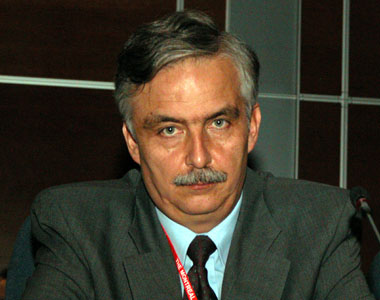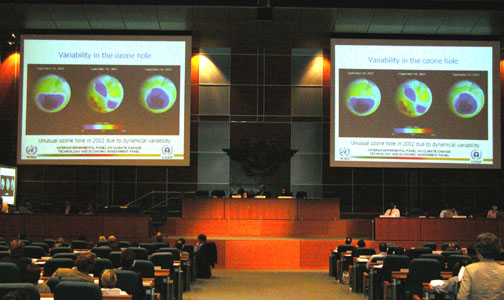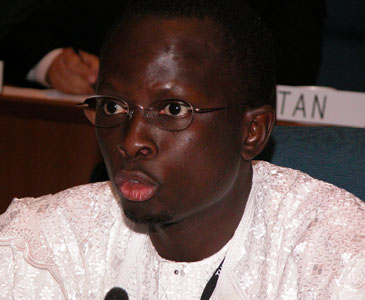|

|
25th Open-ended Working Group of the Parties to
the Montreal Protocol and Second
Extraordinary Meeting of the Parties
27 June - 1 July 2005, Montreal,
Canada
|
|
|
|
Earth Negotiations Bulletin - ENB
|
|
Daily Web
coverage
|
Mon 27
|
Tue
28
|
Wed
29
|
|
|
Thu
30
|
Fri
1
|
|
|
|
|
|
|
|
SUMMARY
|
English
|
French
|
Spanish
|
|
|
HTM
|
PDF
|
TXT
|
HTM
|
PDF
|
TXT
|
HTM
|
PDF
|
TXT
|
|
|

|

|

|

|

|

|

|

|

|
|
|
|
|
|
|
|
|
|
|
|
|
Click on the above days to view previous ENB Web coverage.
|
|
|
Highlights
for Monday, 27 June 2005
|

|
|
The Twenty-fifth meeting of the Open-ended Working Group to the
Montreal Protocol on Substances that Deplete the Ozone Layer (OEWG-25) began on
Monday morning. Executive Secretary of the Ozone Secretariat, Marco
Gonzalez, made an opening statement and paid tribute to Manfred Schneider, Austria, who passed away in
the December 2004 tsunami disaster.
The agenda was adopted with minor additions. Delegates then took
up issues arising out of the 2005 progress report of the Technology and
Economic Assessment Panel (TEAP). In the afternoon, delegates resumed
their consideration of TEAP-related matters and Modou
Diagne Fada,
Minister of Environment and Protection of Nature, Senegal, updated delegates on preparations
for MOP-17 in Dakar,
Senegal.
Above photo: Delegates held a minute of silence for Manfred Schneider, Austria.
|
|
|
|
|
OPENING
PLENARY:
|
|
|
|
The
Twenty-fifth meeting of the Open-ended Working Group to the
Montreal Protocol on Substances that Deplete the Ozone Layer (OEWG-25) began today in Montreal, Canada. Marco González, Executive Secretary of the Ozone
Secretariat, noted that the approaching success of developed countries
in phasing out the use of chlorofluorocarbons (CFCs) in metered-dose
inhalers (MDIs) provides an example for how
Parties may phase out methyl bromide. He urged Parties that have not
yet ratified the amendments to the Protocol to do so and noted the
importance of the outcome of discussions on the Multilateral Fund for
the Implementation of the Montreal Protocol.
|
|

|

|

|
|
Above
photos L-R: Above photos L-R: OWEG-25 Co-Chairs David Okioga, (Kenya) and Thomas Land
(US), and Executive Secretary of the Ozone Secretariat, Marco González
|
|
|
|
|
|

|

|
|
Above photos: Paul Krajnik (Austria), made a brief statement about Manfred Schneider
and participants had a minute of silence in plenary in his honor.
|
|
Issues
arising out of the 2005 Technology and Economic Assessment Panel
progress report (TEAP):
|
|
ESSENTIAL
USE NOMINATIONS: Ashley Woodcock, Medical Technical Options
Committee (MTOC) Co-Chair, discussed essential-use nominations, noting
the need for updated information in 2006 before considering nominations
for 2007. On 2006 nominations, he reported on the basis of the revised
quantities recommended for Russia
and the US.
MTOC Co-Chair, José Pons, stressed
that essential uses should only be allowed when pre-1996 stocks of
appropriate quality and quantity are unavailable .
The EC highlighted a discrepancy in TEAP
recommendations for CFC MDIs and CFC-free MDIs. The US emphasized the need for
a decision by the Parties during MOP-17 on 2007 essential-use exemptions.
Colombia expressed concern
over the lack of technical and financial resources for destroying
stockpiles and suggested that TEAP analyze the cost of destruction. Switzerland
underscored the importance of following the development of emerging
technologies. He, with Nigeria,
recommended coordination amongst conventions and protocols dealing with
persistent organic pollutants and destruction technologies.
|
|
|
|

|
|
Above photo
L-R: The dais of TEAP members with Ashley Woodcock, José Pons, Lambert Kuijpers,
Ian Porter, Radhey Agarwal and Michelle Marcotte
|
|
|
|
|
|
|
Above photo
L-R: Tom Batchelor (EC), John Thompson (US) and Javier Camargo
(Colombia)
|
|
|
|
TEAP
MEMBERS:
|
|

|

|

|

|
|
Above
photos L-R: Ashley Woodcock, Jose Pons,
Miguel Quintero, and Dave Catchpole
|
|
|
|
|
|
|
FOAMS: Miguel Quintero, Foams Technical Options
Committee (FTOC) Co-Chair noted the focus on end-of-life issues,
progress in CFC-11 phaseout, and the
vulnerability of the foam industry to HFC shortages. Presenting TEAP's Foams End-of-Life Taskforce Report, Paul
Ashford, Co-Chair of the Taskforce, highlighted that: the potential
of recovery from appliances has been demonstrated; there is
insufficient experience with building foam; a better understanding of
landfills is needed; and, the combined benefits of reducing
greenhouse gas and ODS emissions is not currently reflected in either
the Montreal or Kyoto Protocols.
|
|
|
|
|
|
|

|

|

|

|
|
Above
photos L-R: Ian Porter, Michelle Marcotte,
Radhey Agarwal
and Lambert Kuijpers
|
|
|
|
|
|
|
HALONS: The Halons Technical Options Committee (HTOC) interim
Co-Chair David Catchpole discussed the need to update HTOC
models for predicting supplies, the difficulty of managing recycling
equipment in Article 5 countries, contaminated halons,
and progress on Decision XV/11.
METHYL BROMIDE: The Methyl
Bromide Technical Options Committee (MBTOC) Convenor
Ian Porter reported on progress towards more balanced MBTOC
membership, new formulations and methods for use in pre-plant soil
use, regulatory and other restrictions affecting use of alternatives,
and MBTOC’s meta-analyses of research
on five crops. Michelle Marcotte, MBTOC Convenor, discussed recapture technology, the
reduction of methyl bromide emissions, expansion of the Handbook on
Critical Use Nominations for Methyl Bromide and the lack of
registered methyl bromide alternatives.
|
|
|
|
|
|
|

|

|

|

|
|
Above
photos L-R: Ian Rae, Masaaki Yamabe,
Paul Ashford and José Pons
(center) answering questions from participants.
|
|
|
|
|
|
|
REFRIGERATION: On behalf of the
Refrigeration, Air Conditioning and Heat Pumps Technical Options
Committee (RTOC), Lambert Kuijpers,
highlighted the increased use of indirect refrigeration systems using
heat transfer fluids in secondary loop delivery systems, and said
that manufacturers and suppliers are reducing system leakage and
improving energy efficiency of mobile air conditioning units in
vehicles.
PROCESS AGENTS: Ian Rae,
Chemicals Technical Options Committee (CTOC), reaffirmed that the US
nomination of CFC-113 satisfies the technical criteria as a process
agent use. The US
noted that the listing of process agents has allowed developing
countries to access funding. Delegates then agreed to process agent
requests from Israel
and the UK.
AEROSOLS: On non-medical
aerosol products, Masaki Yamabe, noted the lack of technical barriers to adoption
of alternatives in this area.
TEAP MEMBERSHIP: Lambert Kuijpers, TEAP Co-Chair, reminded parties
that co-chairs for CTOC, HTOC and MBTOC will be proposed again at
MOP-17 and urged Parties to consider innovative ways of supporting
non-Article 5 experts.
|
|
|
|
|
|

|

|
|
|
|
Above photos L-R: Lambert Kuijpers and
Susan Solomon (IPCC); IPCC/TEAP presentation on the satellite view
of the ozone layer.
|
|
|
|
TEAP/IPCC REPORT: Susan Solomon
(IPCC) and Lambert Kuijpers (TEAP) presented
a draft joint assessment report prepared by the TEAP and the
Intergovernmental Panel on Climate Change. Commenting on the report, Senegal, opposed by the US, suggested a follow-up experts’
workshop, while New
Zealand called for a policy
workshop. Japan, with Argentina
and opposed by the US
and China,
called for continuous cooperation with the Kyoto Protocol. The EC, with
Argentina and New Zealand,
called for a report on this topic at MOP-17. The US said this forum was not appropriate
for some of the emissions reduction ideas discussed, as they are beyond
the Montreal Protocol obligations, while New Zealand said this forum
was the appropriate one.
Greenpeace International recommended that
Parties: instruct the Multilateral Fund to stop funding HFC and HCFC
projects where alternatives exits; accelerate HFC phaseout
in the Montreal Protocol; and assist Article 5 countries phasing out HFCs and HCFCs, noting
that these measures will help protect the climate. The Alliance for Responsible Atmospheric
Policy affirmed the long-term role of HFCs in
replacing ODS.
|
|
Above photos
L-R: Nik Kiddle
(New Zealand), Mitsuhiko Shinomiya
(Japan), Zhang Mengheng (China) and János Máté (Greenpeace)
|
|
|
|
|
Modou Diagne Fada, (right)
Minister of Environment and Protection of Nature, Senegal, updated delegates on
preparations for MOP-17 in Dakar, Senegal.
|

|
|
|
This service was prepared in
cooperation with the Ozone Secretariat
|